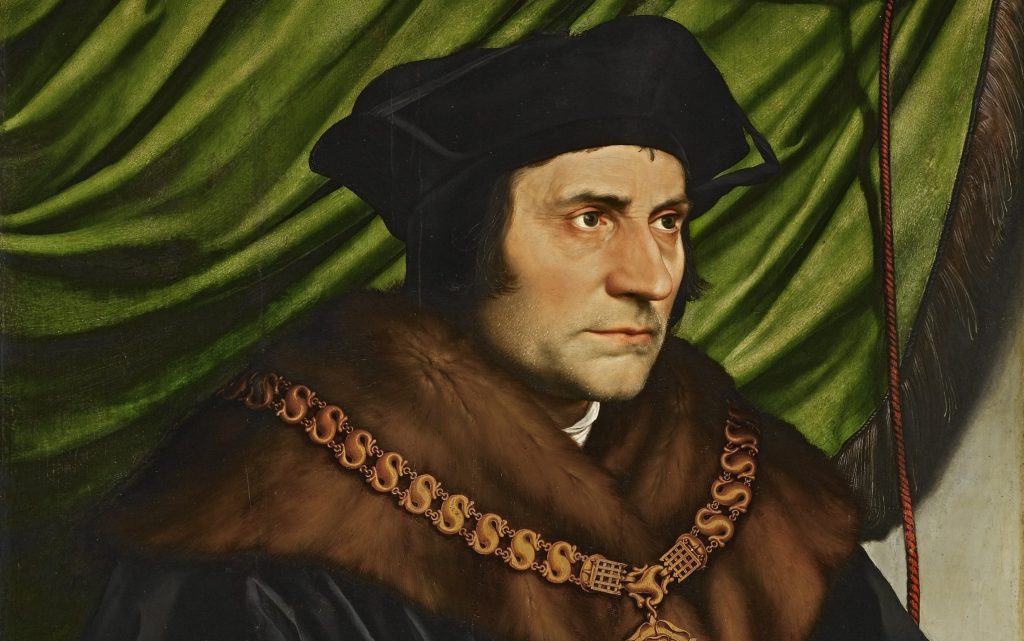St. Thomas More was born in 1478, the son of John More, a prominent lawyer and judge, and his wife Agnes. Thomas received a classical education, and became the protege of Archbishop John Morton, the Lord Chancellor, at age 13. Thomas never joined the clergy, but eventually took on his mentor’s civic position.
Thomas studied at Oxford, becoming a “renaissance man.” He knew several ancient and modern languages, and was proficient in math, music, and literature. His father was determined that Thomas should become a lawyer, so he withdrew him from Oxford after two years to follow that career path.
Despite his talents, Thomas was confused about his vocation. He seriously considered joining the Carthusian monastic order or the Franciscans, and followed many ascetic and spiritual practices like fasting, corporal mortification, and regular prayer, to grow in holiness.
In 1504, Thomas was elected to Parliament. He gave up his monastic ideas, and married Jane Colt of Essex. They were happily married for several years, and had four children together, although Jane died tragically in childbirth in 1511. Shortly after her death, More married a widow, Alice Middleton, who was a devoted wife and mother.
In 1509, King Henry VIII took the throne. For many years, the king showed a fondness for Thomas, working to further his career in the political world. Thomas became part of the king’s inner circle, and was named Lord Chancellor. He also authored a book in Henry’s name, defending Catholic doctrine against Martin Luther.
However, the two men clashed when Henry sought an annulment for his marriage to Catherine of Aragon. Pope Clement VII declared the marriage to be valid, and indissoluble. By 1532, Thomas had resigned as Lord Chancellor, refusing to support the king’s efforts to defy the pope and control the Church.
In 1534, Henry declared that every subject of the British crown would have to swear an oath affirming the validity of his new marriage to Anne Boleyn. Refusal would be considered treason.
In April of that year, Thomas was summoned to take the oath. He accepted certain portions of the act that handled Henry’s royal line of succession, but Thomas could not affirm the king’s actions in defying the pope. He was taken from his wife and children and imprisoned in the Tower of London.
For 15 months, Thomas’ wife and friends tried to convince him to take the oath and save his life, but he refused. In 1535, during Thomas’ imprisonment, Henry passed an act of Parliament declaring him to be the “only supreme head on earth of the Church in England.” Again, refusal to comply would be considered treason, and clergy members who refused to take the oath were executed.
In June 1535, Thomas was indicted and formally tried for the crime of treason in Westminster Hall. He was charged with opposing the king’s “Act of Supremacy” in private conversations, which he insisted did not happen. But after he was sentenced to death, Thomas spoke out in open opposition of the king’s actions.
Thomas explained that the Act of Supremacy was contrary “to the laws of God and his holy Church.” “No temporal prince,” he said, could take away the prerogatives of St. Peter and his successors. When he was told that the English bishops had largely accepted the king’s order, Thomas said the saints in heaven did not accept it.
On July 6, 1535, Thomas was sentenced to be beheaded. “I die the king’s good servant,” he told the crowd, “but God’s first.” He was 57 years old.
Thomas’ head was displayed on the London Bridge, but later returned to his daughter Margaret, who preserved it as a holy relic of her father.
In 1886, St. Thomas More was beatified by Pope Leo XIII, and canonized in 1935 by Pope Pius XI. The Academy Award-winning film “A Man for All Seasons” portrays the events that led to Thomas’ martyrdom.

